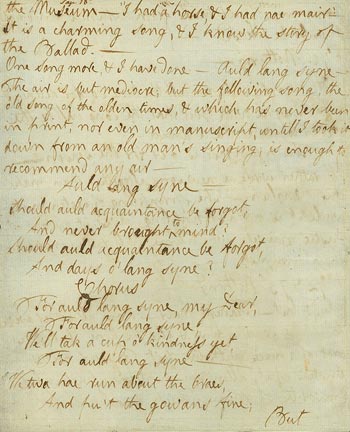
Robert Burns, “Auld Lang Syne” (detail), autograph manuscript written within a letter, dated (September 1793), to George Thomson
Morgan Library & Museum
225 Madison Ave. at 36th St.
Tuesday – Sunday through February 5, $15 (free Fridays 7:00 – 9:00)
212-685-0008
www.themorgan.org
Tonight at midnight, people around the world will break out into the same song, “Auld Lang Syne,” welcoming in 2012, but how many of those revelers know the true story about the famous tune? The Morgan Library is currently hosting a splendid little exhibition that examines the details behind the music and lyrics of the popular ditty, whose three-word title translates to “old,” “long,” “since.” It was Scottish poet Robert Burns who combined the familiar music and lyrics for publisher James Johnson in 1796, although there were different versions both before and after, from a 1667 lover’s lament and a 1760s Caledonian country dance to William Shield’s 1782 opera, Rosina, and Rudyard Kipling’s 1900 Boer War revision. The show, which comprises original letters, manuscripts, portraits, rare books, and even an arrangement by Beethoven, also features a strong online component where you can read and listen to snippets of the evolution of the complete song, so you’ll be able to surprise your fellow partyers tonight by breaking out into all four Burns stanzas, including “We twa hae run about the braes, / And pu’t the gowans fine; / But we’ve wander’d mony a weary foot, / Sin auld lang syne.” In addition, the Morgan will be celebrating the eve of Burns Day on January 24 with the special concert “Days of Auld Lang Syne: Euan Morton Sings Songs of Scotland,” in which the singer and actor will perform Scottish works, accompanied by composer Bryan Reeder on piano. (Also currently on view at the Morgan are “Charles Dickens at 200,” “Treasures of Islamic Manuscript Painting from the Morgan,” and “David, Delacroix, and Revolutionary France: Drawings from the Louvre.”